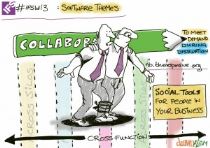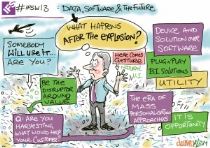This is one of a series of live blog posts directly from the site of the 2013 IFS World Conference in Barcelona. Business journalist Adam Tinworth is a veteran of Reed Business Information and a lecturer on digital journalism at City University in London. His first-hand impressions are accompanied by illustrations of Matthew Buck, cartoonist for Drawnalism.
 There’s an emergent phenomenon whereby people use the internet to facilitate online connection to arrange offline collaboration. AirBnB and BlaBlaCar are good examples of this: the former for renting properties or rooms hotel-like and the latter commercialising car-shading.
There’s an emergent phenomenon whereby people use the internet to facilitate online connection to arrange offline collaboration. AirBnB and BlaBlaCar are good examples of this: the former for renting properties or rooms hotel-like and the latter commercialising car-shading.
Crowd-funding is becoming a new solution for funding the creative industries. Unbound is a variation on that for book publishing. It’s based on a pool of money which is only given to the would-be creator when the campaign is funded. Vyclone does multi-camera footage of events using uploaded user videos.
Rav Dhaliwal – Yammer
If there’s no photo, it never happened. At least that’s what they say internally at Yammer – a freemium internal social network bought by Microsoft last year.
Europe is undergoing an unprecedented financial, social and political change. The old tools aren’t fit for purpose in solving this. Organisations are not built for change – they’re designed to be stable, consistent and efficient. They’re based on the need for repeatable, predictable processes born of the mass manufacturing age. The drawback of focus on efficiency is it quakes innovation.
The org chart is born of this era – but it creates silos. It also doesn’t reflect how we really work. We create ad-hoc groups from across companies – and even outside it. Those silos are often found in information systems as well. No silo responds well to change and disruption.
in 1999, Blockbuster IPOed for $4.2bn. The same year, Reed Hastings founded Netflix. In 2010, Blockbuster filed for bankruptcy, having tried to respond to disruption by just building more stores.
IT departments have been a traditional silo. Many IT departments missed the opportunity of cloud computing – because they saw running severs as their job. The confused what they do with the value they provide. Change is accelerating. Fortune 500 companies fail at the rate of 8% a year – and it’s accelerating.
Companies that are using social tools to become networks are able to compete better, because they’re able to adapt better. Disruption is when someone else figures out how to provide the value you do in a better way. Yammer’s value is not its product – it’s in helping organisations become more open and connected.
The key is not to frame your organisation as what you do, but as what your customers need. Tools like Yammer help you recognise the opportunity to adapt – and to do it quickly. It allows people to self-organise. Social tools allow people to align themselves around common goals, rather than features or functions. The need to change is not an indication of failure. Our customers are changing, so we must.
Ultimately, we want to change from the rigid hierarchy reflected in an org chat into a network, that can concentrate on providing value. You can use social tools to ease this process, by opening the conversation up to your employees. But don’t do it alone. We’ve set up TheResponsiveOrg.com to help you connect with like minded people.
Frode Huse Gjendem, Accenture
 More and more companies are using analytics aggressively – it’s becoming seen as one of the new competencies for the future. 66% of companies have a chief data officer or smilier. While there’s a high level of commitment, it’s matched by a high level of openness in sharing that information upstream to suppliers, and downstream to sales channels. More companies are open to buying the data they need. But only 20% are getting satisfactory results – despite 40% thinking they have the right data. The problem? They don’t have an aligned business model. They might make the right decision – but they can’t implement it fast enough.
More and more companies are using analytics aggressively – it’s becoming seen as one of the new competencies for the future. 66% of companies have a chief data officer or smilier. While there’s a high level of commitment, it’s matched by a high level of openness in sharing that information upstream to suppliers, and downstream to sales channels. More companies are open to buying the data they need. But only 20% are getting satisfactory results – despite 40% thinking they have the right data. The problem? They don’t have an aligned business model. They might make the right decision – but they can’t implement it fast enough.
Can you use drones to fly pipelines and identify erosion or other problems along the way. Can retailers benefit from more detailed, long-term weather assessments? We have a series of approaches to making the right strategy and getting it implemented. This is not magic – it’s what companies come to us for.
You need to identify the data you need – don’t get lost in a forest of data. Once you know the data, you can figure outré the metrics and insights you need to make business decisions. You need to know how long you can fly an aircraft before it needs pulling and you have a cancellation – and plan for it being out of service two journeys before that.
The future is predictive analytics.
An agricultural equipment manufacturer is using data form customers and putting it in a database that can alters them of a growing problem. That can be fed back to design or manufacturing, and the problem eliminated on the production line as soon as possible.
Hospitals can use this techniques to reduce costs while improving care. Using new data, mixed with patient behaviour data, you can predict issues.
Panel Discussion
- Frode Huse Gjendem, Accenture
- Rav Dhaliwal, Yammer
- Mike Opal, Microsoft
- Dan Matthews, IFS
- Ray Wang, Constellation Partners
RW: The way we look at software is going to change – apps has consumerized software to where we are now.
DM: Poeple are still buying what we sell – bury what we’re selling is business enablement
RW: People aren’t buying products and service, they’re buying experiences and outcomes.
MO: We’ve rebranded around product and services, not software. That’s deliberate word choice. When I think about the future of technology, the cloud is going to be the lion’s share of computing, and people won’t think about device speed. It will come.
RW: Where do you go for your apps? For direction? The cloud. It’s already here.
FG: It’s so much easier to package intellectual property into something that plugs into an enterprise system – that will have a disruptive effect on the business solution market.
RD: The combination of cloud and mobile will be a disruptive force. They want to consume them like gas and electricity – as a utility. The days of buying servers and racks is gone for companies.
RW: We’ve gone from a world of transitions, through a world of engagement to a world of experiences. We’re developing human APIS, to use our abodes – or brains to control things. And we’re heading towards the worlds of mass personalisation.
MO: Our kids won’t grow up thinking about keyboards – they’ll be gesturing at the computer and having their body language read. We do over-rely on data sometimes. That’s what we did in 2007 in the financial markets – and we were wrong
RD: We’ll stop talking about software soon. We’ll ust think about what we want to do.
RW: It’s a very different world when we are making the decision between trusting the machines – or human judgement.
DM: We’ll see business software coming back, and being better at work than at home, as it sued to be.
MO: I think the future IT worker is a Math person. The computers will give us the tools, and we’ll need the math skills to use the data we’re gathering.